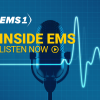Editor’s Note: Welcome to the What Paramedics Want podcast series of Inside EMS, sponsored by Pulsara. The state of the industry What Paramedics Want Report explores issues tied to provider recruitment and retention; safety, health and wellness support; technology adoption; and career development, produced in partnership with Fitch & Associates and the National EMS Management Association. Learn more and download your copy.
In this special crossover episode of Inside EMS and EMS One Stop, host Rob Lawrence is joined by Matt Zavadsky of PWW Advisory Group and Rodney Dyche of PatientCare EMS for an in-depth look at the biggest EMS stories of 2024. From critical staffing shortages to groundbreaking changes in system design, the trio tackles how the EMS landscape has evolved and what lies ahead for 2025.
A key tool driving this discussion is the EMS Media Log, maintained collaboratively by the American Ambulance Association (AAA) and the Academy of International Mobile Healthcare Integration (AIMHI). This log aggregates EMS-related news stories from local, regional and national outlets across the U.S.
Sources are gathered from reputable media platforms, local newspapers and firsthand accounts. Once collated, these stories are categorized and analyzed to uncover emerging trends, shared challenges and opportunities for advocacy. The log is not only a resource for industry professionals, but also a powerful tool to educate elected officials and policymakers, demonstrating how seemingly local issues often reflect nationwide trends.
This lively discussion explores how data from the EMS Media Log has illuminated topics like tiered response models, legislative battles for better funding, and solutions to ambulance thefts and ambulance patient offload time (APOT) delays. Packed with insightful quotes, actionable strategies, and the latest data, this episode is a must-listen for EMS professionals striving to shape a better future for their communities.
Memorable quotes
“If we do what we always did, Matt, we’ll get what we always got.” — Rob Lawrence
“Stop trying to get to every call in 11 minutes. Stop putting the paramedic on every ambulance. And I was surprised at how receptive the community was to that, because the science does show that.” — Matt Zavadsky
“Stop leaving the money on the table that should be going for these services. Take the burden off the taxpayer and put the responsibility back on those that should be paying that.” — Rodney Dyche
“Culture eats strategy for breakfast, right? So many times we go into communities, and they’re doing 80-90% of their responses lights and siren.” — Matt Zavadsky
“There were 26 thefts in our log from this year in 18 different states, and six of those resulted in significant crashes.” — Rodney Dyche
“We need to work hard to ensure that we don’t have that statistic in 2025, an ambulance stolen every 2 weeks.” — Rob Lawrence
“For patient safety, community safety, this is something that is a zero-failure option, and if you fail to secure your vehicle, you can go work somewhere else. Period.” — Matt Zavadsky
“Be the best part of the worst day of their lives, and we will continue, I know, to do that.” — Rob Lawrence
“If you don’t have the influence to affect the vote, it’s not going to go your way.” — Rob Lawrence
“The cost across all providers – average cost across the country to put an ambulance in front of an address – $2,600 and change. The average reimbursement across all payers for that same cohort? $1,200. And Medicare pays half of that.” — Matt Zavadsky
Timeline
00:23 – Podcast Kickoff: Rob welcomes listeners and co-hosts, introduces the year-end news review theme
01:41 – The Importance of the Media Log: Rob explains how the AAA/AIMHI news log illuminates shared EMS challenges
04:47 – Tiered deployment: Matt discusses Multnomah County’s transition to a single-paramedic model and tiered deployment
06:56 – Hospital bed delays: Rodney highlights the Asheville County lawsuit over APOT and wall times
14:41 – Mecklenburg’s success: Matt praises Mecklenburg County’s evidence-based shift to extended response times for low-acuity calls
26:04 – Ambulance theft prevention: Rob and Rodney emphasize vehicle security and its impacts on public safety
31:07 – Ground ambulance data collection: Matt reveals key insights from the latest CMS report on funding shortfalls
39:09 – The power of local data: Rodney underscores the importance of leveraging local stories to highlight national EMS issues
43:12 – Positive developments: Rodney and Matt celebrate community-driven funding wins in Pennsylvania, Minnesota and Iowa
45:54 – Closing remarks: Rob recaps key takeaways and previews a proactive 2025 for EMS advocacy
ADDITIONAL RESOURCES
- AAA/AIMHI Media Log
- Medicare ground ambulance data collection system (GADCS) report year 1 and year 2 cohort analysis December 2024
- Patterns in California ambulance patient offload times by local emergency medical services agency
- Donnie Woodyard books
- Is ‘regression’ our path forward? Matt Zavadsky challenges EMS system design
- Ambulances held hostage: EMS strategies for reducing ambulance offload times
ABOUT THE SPONSOR
Whether replacing radio reports, alerting specialty teams, or managing mass casualty incidents, Pulsara simplifies communication. Pulsara scales to meet your dynamic communication needs. From routine patient alerts to managing large-scale emergencies, every responder and clinician connects seamlessly. Familiar yet powerful, Pulsara streamlines your response, from routine transfers to regional disasters. One tool. Every day. Regardless of event. Discover more at Pulsara.com.
RATE & REVIEW
Catch a new episode of the Inside EMS podcast every Friday on Apple Podcasts, SoundCloud, Amazon Music, Stitcher, Spotify, and RSS feed.
Enjoying the show? Please take a moment to rate and review us on Apple Podcasts. Contact the Inside EMS team at theshow@ems1.com to share ideas, suggestions and feedback, or let us know if you’d like to join us as a guest.
EMS1 is using generative AI to create some content that is edited and fact-checked by our editors.


